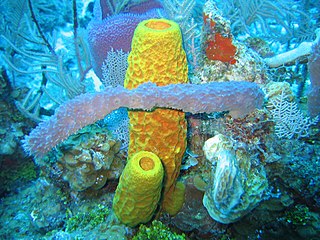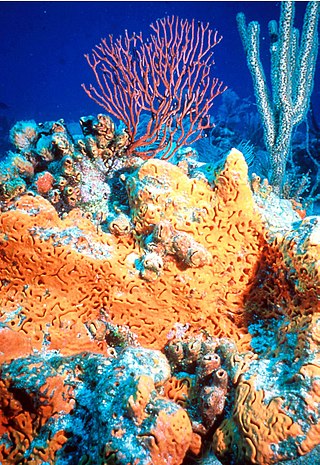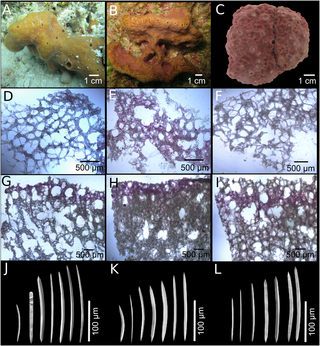
Sponges or sea sponges are primarily marine invertebrates of the metazoan phylum Porifera, a basal animal clade and a sister taxon of the diploblasts. They are sessile filter feeders that are bound to the seabed, and are one of the most ancient members of macrobenthos, with many historical species being important reef-building organisms.

Demosponges (Demospongiae) are the most diverse class in the phylum Porifera. They include greater than 90% of all species of sponges with nearly 8,800 species worldwide. They are sponges with a soft body that covers a hard, often massive skeleton made of calcium carbonate, either aragonite or calcite. They are predominantly leuconoid in structure. Their "skeletons" are made of spicules consisting of fibers of the protein spongin, the mineral silica, or both. Where spicules of silica are present, they have a different shape from those in the otherwise similar glass sponges. Some species, in particular from the Antarctic, obtain the silica for spicule building from the ingestion of siliceous diatoms.

Stromatoporoidea is an extinct clade of sea sponges common in the fossil record from the Middle Ordovician to the Late Devonian. They can be characterized by their densely layered calcite skeletons lacking spicules. Stromatoporoids were among the most abundant and important reef-builders of their time, living close together in flat biostromes or elevated bioherms on soft tropical carbonate platforms.
The black stink sponge, is a species of sea sponge in the family Irciniidae. This sponge is known around the Australian coast and around South Africa from the Cape Peninsula to Cape Agulhas.

Spongilla lacustris is a species of freshwater sponge from the family Spongillidae. It inhabits freshwater rivers and lakes, often growing under logs or rocks. Lacustris is a Latin word meaning "related to or associated with lakes". The species ranges from North America to Europe and Asia. It is the most common freshwater sponge in central Europe. It is the most widespread sponge in Northern Britain, and is one of the most common species of sponges in lakes and canals. Spongilla lacustris have the ability to reproduce both sexually and asexually. They become dormant during winter. The growth form ranges from encrusting, to digitate, to branched, depending upon the quality of the habitat.

Amphimedon compressa, the erect rope sponge, red tree sponge, red tubular sponge, or red sponge is a demosponge found in southern Florida, the Caribbean Sea, and the Bahamas. It can be deep red, orange, brown, or black.
Ophlitaspongia papilla is a species of demosponge belonging to the family Microcionidae. It is found along north-eastern Atlantic coastlines. This is a red sponge which forms thin, smooth encrusting patches, up to 5 cm across, with regularly spaced oscula.

Agelas is a genus of sea sponge in the class Demospongiae.
Neofibularia nolitangere, commonly known as the touch-me-not sponge, is a species of sea sponge in the family Biemnidae. It is found in shallow waters in the Western Atlantic Ocean and the Caribbean Sea.
Aplysina insularis, commonly known as the yellow-green candle sponge or yellow candle sponge, is a species of sea sponge found on reefs in the Caribbean Sea and the Gulf of Mexico.
Agelas flabelliformis, also known as the elephant ear sponge, is a species of demosponge. It takes the form of a large leathery slender flap and is found in the Caribbean area at depths down to 100 metres (330 ft).

Neopetrosia proxima is a species of marine petrosiid sponge native to the tropical and subtropical waters of the western Atlantic Ocean.
Agelas dispar is a species of demosponge in the family Agelasidae. It lives on shallow-water reefs in the Caribbean Sea and around the West Indies.
Hymeniacidon kitchingi is a species of sponge in the class Demospongiae. It is found in shallow waters in the northeastern Atlantic Ocean. This species was first described in 1935 by the British zoologist Maurice Burton. He placed it in a new genus because of its unusual spicules, and named it Rhaphidostyla kitchingi, in honour of Dr J. A. Kitching, who had collected the original specimen. It was later transferred to the genus Hymeniacidon.
Halisarca caerulea is a species of sponge in the family Halisarcidae. It is native to the Caribbean Sea and was first described in 1987 by the French marine biologists Jean Vacelet and Claude Donadey.
Calcifibrospongiidae is a family of sponges belonging to the order Haplosclerida. The order Haplosclerida is distinguished by isodictyal skeleton. In general, Porifera are basal animals with bodies full of pores and channels. Calcifibrospongiidae includes the species Calcifibrospongia actinostromarioides. There have only been ten recorded occurrences of this species: in Hogsty Reef and San Salvador, as well as in the subtropics of the Bahamas.

Spirastrella coccinea is a species of marine sponge in the family Spirastrellidae. It is found in the tropical western Atlantic Ocean, the Caribbean Sea, and the Gulf of Mexico.
Oscarella tuberculata is a species of sponge in the order Homosclerophorida. It is endemic to the Mediterranean Sea, where it forms encrusting colonies on rocks and other hard surfaces.

Monanchora is a genus of demosponges belonging to the family Crambeida. The genus contains 18 species, which have been researched for their potential use in medicine.











